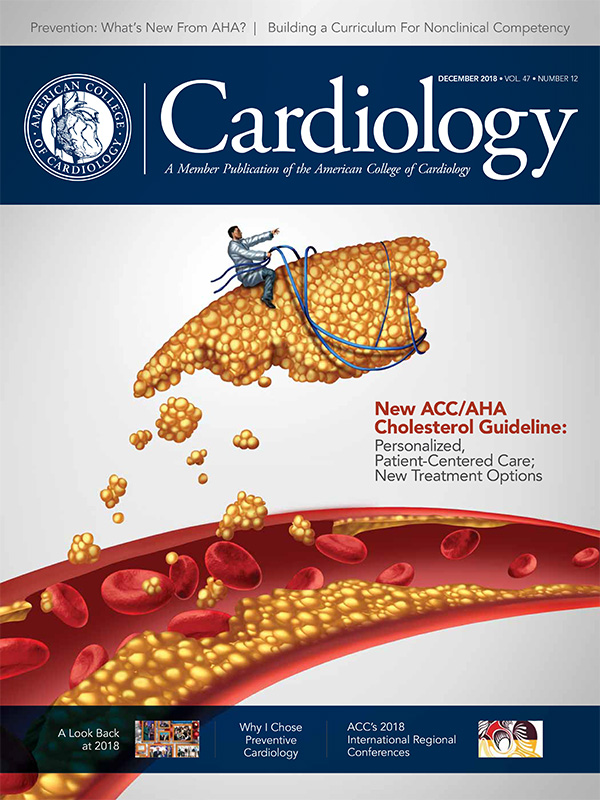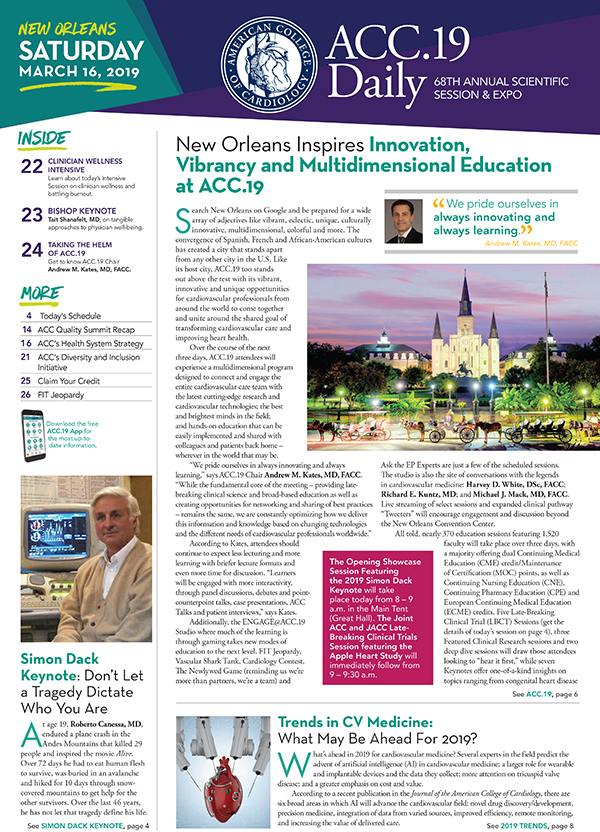Trends in Cardiovascular Medicine: What May Be Ahead For 2019?
Cardiology Magazine Early Release Feature

What's ahead in 2019 for cardiovascular medicine? That's the question we asked several experts in the field. Their predictions?
Greater use of direct oral anticoagulants (DOACs) in atrial fibrillation (AFib) and other conditions; new paradigms in the management of mitral valve regurgitation (MR) in heart failure patients; increased use of transcatheter aortic valve replacement (TAVR); a larger role for wearable and implantable devices and the data they collect; the advent of artificial intelligence (AI) in cardiovascular medicine; and a greater emphasis on cost and value.
Atrial Fibrillation
 Geoffrey Barnes, MD, FACC
Geoffrey Barnes, MD, FACC
It's been eight years since the U.S Food and Drug Administration (FDA) approved the first DOAC, dabigatran. Since then, the use of dabigatran and the other DOACs, rivaroxaban, apixaban, edoxaban and betrixaban, as the preferred anticoagulant prophylaxis for patients with AFib has risen significantly. Indeed, although the use of anticoagulation in AFib patients remains suboptimal, there is evidence that the percentage of patients prescribed anticoagulation has increased since their introduction.1,2
So what's next? Geoffrey Barnes, MD, FACC, of the University of Michigan, predicts:
- Greater use of DOACs over warfarin now that drug-specific reversal agents are available.
- Increased use of DOACs in other patient populations, such as those with cancer-associated venous thromboembolism (VTE).
- Increased use of DOACs, particularly rivaroxaban, among patients with atherosclerotic disease. This is a result of the COMPASS study, he says, which showed fewer cardiovascular and limb events in patients with peripheral artery disease (PAD) who received twice daily, low-dose rivaroxaban plus daily aspirin compared with aspirin alone. Similar results are anticipated from a second trial, VOYAGER PAD.
These studies, says Barnes, "are helping us understand the role of very low-dose DOACs in the prevention of thrombotic adverse events in patients with coronary artery disease and PAD."
Another major story in the AFib realm for 2019, he predicts, will be increased detection, possibly over detection, of rhythm abnormalities given the advent of wearable devices with built-in heart rate monitors and single-lead electrocardiograms (ECGs). "This will likely raise concerns among the public about potential tachyarrhythmias," he says. "How cardiologists assess these patients and how they determine if the alarms are 'true positive' or 'false positive,' and how they will decide if anticoagulation is needed, remains a key challenge for our field."
In addition, 2019 should see results from the AUGUSTUS trial, which is exploring the effects of apixaban vs. warfarin with or without aspirin on patients with AFib. "This study, along with the recently completed PIONEER AF-PCI study, will help clinicians determine the safety of antithrombotic regimens for patients with concurrent AFib and coronary artery disease," says Barnes.
Artificial Intelligence
The steam engine triggered the first industrial revolution; electric power the second; and electronics and digital technology the third. But it is the fourth industrial revolution, characterized by a "fusion of technologies blurring the lines between the physical, digital, and biological spheres," that holds the greatest potential for revolutionizing medicine.3 At its core is AI and machine learning.
Artificial intelligence is defined as the ability of computer systems to perform tasks humans usually perform. Machine learning, while often used interchangeably with AI, is actually a subset of AI in which algorithms, mathematical models and/or computer systems are used to optimize the performance of a given task.
 Ty J. Gluckman, MD, FACC
Ty J. Gluckman, MD, FACC
"Simply put, machines learning for themselves," said Ty J. Gluckman, MD, FACC, medical director at the Center for Cardiovascular Analytics, Research and Data Science at Providence Heart Clinic in Portland, Oregon.
A recent publication in the Journal of the American College of Cardiology highlighted six broad areas in which AI will advance the cardiovascular field:4
- Novel drug discovery/development. "AI is increasingly being used to refine the selection of potential therapies by searching for patterns in molecular biology, structure-function, and clinical trial databases," says Gluckman.
- Precision medicine. With AI, genetic information, environment and lifestyle can be quickly assessed to determine who is most likely to benefit from certain interventions, he says.
- Integration of data from varied sources. AI enables data from varied sources, such as wearables, social media, the electronic health record (EHR), and the -omics, to be integrated into models that can predict the trajectory of both health and disease.
- Improved efficiency. AI can help reduce provider dissatisfaction and burnout by minimizing repetitive tasks, prioritizing EHR-based alerts or messages, improving and automating image interpretation in the catheterization or echocardiography laboratory, and presenting a "preferred" treatment plan based on integration of varied data sources, Gluckman says.
- Remote monitoring. AI can strain out clinically actionable data from the trillions of data bytes wearable devices collect.
- Increasing the value of delivered care. "Artificial intelligence is an ideal population tool," Gluckman says, given its ability to better predict individuals at greater or lesser risk of developing chronic diseases or related complications, tailoring preventive therapies and allocating limited resources to those most likely to benefit from them.
 John Rumsfeld, MD, FACC
John Rumsfeld, MD, FACC
However, says John Rumsfeld, MD, FACC, ACC Chief Innovation Officer, "no emerging technology has more promise – or more hype – than AI. There are dozens of articles about the potential for AI in health care and an increasing number of scientific publications. But, overall, almost nothing has yet made its way into clinical practice."
One likely reason, he notes, is that many start-up and established tech companies underestimated the complexity of health care data and the need to provide strong evidence that the use of AI would improve efficiency and outcomes.
In addition, AI can be a "black box" to clinicians, he says. "We may not embrace it when we can't understand how or why the computer is making a prediction or recommendation." That's why it's so important that clinicians insist on strong data before relying on AI. "At the end of the day, we don't need more data and risk models, but useful information that we can act on clinically."
Ultimately, however, he says there is "no doubt" that AI will impact health care. "The question is when and in what manner?"
Patient-Generated Data

The first "wearable" in cardiovascular medicine dates back to the 1800s, when a watch with a second hand was used to measure heart rate.5 Today, however, wearables are more likely to be patient initiated, measuring everything from heart rate and rhythm to blood pressure, sleep quality and duration, and physical activity. Which begs the question: do these devices improve patient outcomes, particularly when it comes to cardiovascular disease prevention?
Possibly. There is some evidence that activity-tracking monitors can change behavior, although the long-term effects remain unknown. However, their accuracy varies, as does consumer acceptance of them, particularly in older people. In addition, most studies evaluate behavior change over a short period of time (a week to 10 days), leaving unanswered the question of any long-term impact, which is required for substantive prevention.6,7
There is particular interest in the ability of wearables to affect clinical outcomes in cardiovascular disease. A major trial evaluating the potential of specialized software for the Apple Watch to detect abnormal heart rhythms is underway. The Apple Heart Study, a virtual, prospective, single-arm pragmatic study has enrolled more than 400,000 participants. The primary outcome is the proportion of participants with an irregular pulse detected by the watch who are diagnosed with AF on subsequent ambulatory ECG patch monitoring. A secondary outcome is to estimate the rate of initial contact with a healthcare provider within three months after the patient is notified of a pulse irregularity.4 Results may come in 2019.
"With that effort, lead investigator Mintu Turakhia, MD, and colleagues are on the cutting edge of AFib identification at scale," says Seth S. Martin, MD, FACC, who directs the Advanced Lipid Disorders Program at Johns Hopkins in Baltimore, MD. "There are real challenges they are tackling thoughtfully. A key will be translating this new approach into better clinical outcomes."
To date, data on clinical outcomes from mHealth devices are primarily based on case studies. For instance, Martin and his colleagues recently reported on the case of a woman with paroxysmal AFib whose Apple Watch/Kardia Band detected tachycardiomyopathy, enabling early identification and treatment and likely preventing significant morbidity.8 "This represents the beginnings of mHealth being integrated into clinical care," he says.
However, barriers exist to greater use of mHealth and wearables in clinical practice today. For instance, while Martin's patients have the Alive Cor app, which records an EKG, on their mobile phone and send him rhythm strips to aid in diagnosis and care, time for interpretation is a factor. The app is valuable, he says, but he's not paid for interpreting the reading, which presents a significant barrier to its clinical use. "It may take insurance companies years to catch up with new technology," he notes. Other major barriers center around privacy and data security.
Valvular Heart Disease
 Brian R. Lindman, MD, FACC
Brian R. Lindman, MD, FACC
The results of the COAPT trial reported in 2018 should have significant implications for the field of valvular heart disease in 2019, our experts say.9 The study, which showed that treatment with the MitraClip combined with guideline-directed medical therapy (GDMT), effectively reduced MR and was associated with marked clinical benefits, "answered one of the lingering, unanswered question in the field," says Brian R. Lindman, MD, FACC, medical director of the Structural Heart and Valve Center at Vanderbilt University Medical Center in Nashville, TN. "Is secondary mitral regurgitation simply a marker of a patient with a poor prognosis or a target for intervention/therapy?" he asks.
The results will encourage efforts to "fix MR" in patients with heart failure and secondary MR, he predicts. "The key will be how to do this in a safe, effective and durable manner." Several questions remain, however, including how generalizable and translatable the results of COAPT will be in clinical practice.
 Roxana Mehran, MD, FACC
Roxana Mehran, MD, FACC
That's the question Roxana Mehran, MD, FACC, professor of cardiology at Mt. Sinai in New York City, also asked. "The COAPT trial was indeed a huge stride forward in treating patients with heart failure and functional MR," she says. However, "It is important to understand that the population of patients in COAPT were carefully selected and only qualified for randomization if they failed GDMT." In addition, patients were systematically followed for assessment of their clinical symptoms and rehospitalizations and events. In contrast, the MITRA-FR trial, which did not show any improvement with the MitraClip compared with medical therapy alone, enrolled heart failure patients with MR as they presented.10
"It is important that future studies are designed to better understand these patients' pathobiology because the treatment paradigms are not the same for all HF pts with MR," says Mehran.
Other study results expected in 2019 include those from two trials comparing TAVR with surgical aortic valve replacement (SAVR) in low-risk patients. "Most people anticipate that TAVR will be noninferior to SAVR, thus opening the door for FDA approval of TAVR to extend to low-risk patients," Lindman says, although several lingering questions remain, including its use in patients with bicuspid valve disease and valve durability.
"We anticipate that if TAVR is noninferior to SAVR, the field of transcatheter approaches for aortic valve will widen and many patients will be eligible for this ground-breaking therapy, which is less invasive and kinder for patient's recovery," Mehran says.
Another question in 2019 is whether the FDA will approve Boston Scientific's Lotus valve for high-risk and prohibitive risk patients, and how the availability of a third TAVR valve on the market will affect practice patterns. "Will certain valves begin to develop niche uses?" Lindman asks.
Both he and Mehran predict greater attention on tricuspid valve disease. Given the lack of medical therapies for advanced tricuspid valve regurgitation, "transcatheter tricuspid therapies offer the possibility of a therapy option where no good therapy currently exists," Lindman says.
Mehran cites other trends for 2019 including the continued growth of treatment options for structural heart disease, as well as a greater understanding of the use of interventional therapies for AFib such as left atrial appendage and patent foramen ovale closures.
Cost and Value in Cardiovascular Medicine

Cardiovascular disease is the costliest disease in the U.S., with direct medical costs of $555 billion in 2016. By 2035, that figure is expected to double to $1.1 trillion.11 While the prevalence of cardiovascular disease is certainly a major contributor, so, too, is the high use of technology in the field, including imaging and devices.
Perhaps one class of drugs that consumes much of the focus regarding cost in this field is the PCSK9 inhibitors. The enthusiasm within the medical community about their capacity to reduce events in patients with atherosclerotic cardiovascular disease (ASCVD) was often tempered by their cost. When initially approved, the PCSK9 inhibitors were priced at up to $15,000 a year, more than 100 times the cost of generic statins. For a drug that must be taken for a lifetime, whether a PCSK9 inhibitor or a statin, costs take on a greater concern.
The most recent cost-effectiveness analysis of alirocumab found the drug would be cost effective at a price up to $6,319 per year at the $100,000 willingness to pay threshold, based on an economic analysis of patients in the recently released ODYSSEY OUTCOMES study.12
As the outcomes data with the PCSK9 inhibitors pile up more and more convincingly, companies like Amgen and Sanofi-Regeneron are also taking steps to address access by lowering costs. In October 2018, Amgen dropped the list price of evolocumab by 60 percent,13 while Sanofi-Regeneron lowered the price of alirocumab in return for exclusivity on pharmacy benefit manager Express Scripts' national formulary.
The new ACC/American Heart Association Guideline on the Treatment of Blood Cholesterol not only incorporated the use of PCSK9 inhibitors for the first time, it included a Value Statement that underscores the need for clinicians and patients to factor in the cost of drugs in determining the most appropriate treatment strategy.14 It remains to be seen if recent reductions in pricing for some PCSK9 inhibitors and results from clinical outcomes results from studies like ODYSSEY OUTCOMES could alter the value equation down the road.
 C. Michael Valentine, MD, FACC
C. Michael Valentine, MD, FACC
"ACC is committed to helping physicians with access to care issues, while also bringing together stakeholders, including payer, industry and clinician representatives, to talk about opportunities to move forward together," says ACC President C. Michael Valentine, MD, FACC. "Our goal is to make sure the highest risk patients have access to the care they need."
"I am hopeful that with the guidelines incorporating PCSK9 inhibitors and Amgen lowering the list price, we will see improved access and better lipid control for our high-risk patients in 2019," says Martin.
 Deepak L. Bhatt, MD, FACC
Deepak L. Bhatt, MD, FACC
Deepak L. Bhatt, MD, FACC, executive director of Interventional Cardiovascular Programs at Brigham and Women's Hospital Heart and Vascular Center in Boston, who led the economic analysis of the ODYSSEY OUTCOMES trial of alirocumab, says he hopes to see more analyses performed based on clinical data vs. modeling to determine cost effectiveness and that manufacturers use this information to match the price vs. pricing it based on what the market will tolerate.
"If that type of analysis is done up front and used to guide the pricing of the drug, it would reduce health care costs and hopefully enable therapies to get to patients who really need them," Bhatt says.
Stents are another high-cost area in cardiovascular medicine. While competition is driving down cost, the U.S. still pays significantly more than other countries, says Bhatt. "My hope is that as additional drug-eluding stents are approved it will drive down costs because the best way to drive down costs is competition."
Another issue that must be discussed in 2019 is the role that reimbursement may play in determining treatment. For instance, while TAVR has greatly improved outcomes in patients with aortic valve disease, particularly those who are not candidates for SAVR, "the irony is that hospitals tend to make much more money off surgical procedures than TAVR," Bhatt notes. "As we move forward with innovation in health care, we have to make certain there is not a penalty for providers adopting new technology that is better for patients, but for which the reimbursement might be worse."
This, in turn, requires that cardiovascular professionals work with policy makers and third-party payers to ensure that "as we're innovating, we're creating reimbursement structures that favor appropriate evidence-based innovation and don't end up stifling its dispersion because of economic incentives."
References
- Alamneh EA, Chalmers L, Bereznicki LR. Suboptimal use of oral anticoagulants in atrial fibrillation: has the introduction of direct oral anticoagulants improved prescribing practices? Am J Cardiovasc Drugs 2016;16:183-200.
- Eek AK, Oie E, Granas AG. Prescribing of NOACs has outnumbered warfarin: exploring how physicians choose anticoagulant treatments. Eur J Clin Pharmacol 2018;74:323-330.
- World Economic Forum. The Fourth Industrial Revolution: what it means, how to respond. 2016. Available here. Accessed Dec. 1, 2018.
- Turakhia MP, Desai M, Hedlin H, et al. Rationale and design of a large-scale, app-based study to identify cardiac arrhythmias using a smartwatch: The Apple Heart Study. Am Heart J 2018;Sept 8:[Epub ahead of print].
- Pevnick JM, Birkeland K, Zimmer R, Elad Y, Kedan I. Wearable technology for cardiology: An update and framework for the future. Trends Cardiovasc Med 2018;28:144-150.
- Duncan M, Murawski B, Short CE, et al. Activity trackers implement different behavior change techniques for activity, sleep, and sedentary behaviors. Interact J Med Res 2017;6:e13.
- Hickey AM, Freedson PS. Utility of consumer physical activity trackers as an intervention tool in cardiovascular disease prevention and treatment. Prog Cardiovasc Dis 2016;58:613-619.
- Ying R, Vasishta S, Martin SS, Sharma G. Tachycardiomyopathy detection: moving beyond arrhythmia detection with Kardia Band. Cardiology 2018;47:20-21. Available here.
- Stone GW, Lindenfeld J, Abraham WT, et al. Transcatheter mitral-valve repair in patients with heart failure. N Engl J Med 2018;Sept 23:[Epub ahead of print].
- Obadia JF, Messika-Zeitoun D, Leurent G, et al. Percutaneous repair or medical treatment for secondary mitral regurgitation. N Engl J Med 2018;Aug 27:Epub ahead of print.
- American Heart Association. Cardiovascular Disease: A Costly Burden For America; Projections Through 2035. 2017. Available here. Accessed Dec 1, 2018.
- Bhatt DL, Briggs A, Reed SD, et al. Cost-effectiveness of alirocumab based on evidence from a large multinational outcome trial: the ODYSSEY OUTCOMES economics study. American Heart Association Scientific Sessions 2018; Chicago; presented Nov 10, 2018.
- Wendling P. Amgen Cuts repatha's price 60% as scrutiny of drug costs heats up. Medscape Medical News. Oct 24, 2018. Available here. Accessed Nov 27, 2018.
- Grundy SM, Stone NJ, Bailey AL, et al. 2018 AHA/ACC/AACVPR/AAPA/ABC/ACPM/ADA/AGS/APhA/ASPC/NLA/PCNA Guideline on the Management of Blood Cholesterol. J Am Coll Cardiol 2018;Nov 10:[Epub ahead of print].
Keywords: ACC Publications, Cardiology Magazine, Academic Medical Centers, Algorithms, American Heart Association, Antibodies, Monoclonal, Anticoagulants, Aortic Valve, Aortic Valve Insufficiency, Arrhythmias, Cardiac, Artificial Intelligence, Aspirin, Atrial Appendage, Atrial Fibrillation, Benzamides, Blood Pressure, Burnout, Professional, Catheterization, Cholesterol, Chronic Disease, Computer Security, Computer Systems, Coronary Artery Disease, Cost-Benefit Analysis, Echocardiography, Drug Discovery, Electrocardiography, Electrocardiography, Ambulatory, Electronic Health Records, Exercise, Foramen Ovale, Patent, Health Care Costs, Heart Defects, Congenital, Heart Failure, Heart Rate, Heart Valve Diseases, Information Storage and Retrieval, Insurance, Health, Reimbursement, Life Style, Lipids, Malus, Mitral Valve, Mitral Valve Insufficiency, Models, Theoretical, Motivation, Neoplasms, Percutaneous Coronary Intervention, Peripheral Arterial Disease, Physician Executives, Prevalence, Privacy, Prognosis, Prospective Studies, Pyrazoles, Pyridines, Pyridones, Random Allocation, Research Personnel, Social Media, Software, Stents, Tachycardia, Telemedicine, Thiazoles, Transcatheter Aortic Valve Replacement, Tricuspid Valve, Tricuspid Valve Insufficiency, United States Food and Drug Administration, Venous Thromboembolism, Warfarin, ACC Scientific Session Newspaper, ACC19, ACC19 Newspaper
< Back to Listings








